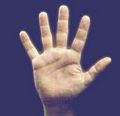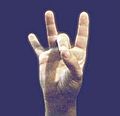Letters and digits
The letters and digits are signed as follows. In informal contexts, the handshapes are not made as distinctly as they are in formal contexts.
- 1
- 2
- 3
- 4
- 5
- 6
- 7
- 8
- 9
- 10
The manual alphabet can be used on either hand, normally the signer's dominant hand – that is, the right hand for right-handers, the left hand for left-handers. [1] Most frequently, the manual alphabet is signed just below the dominant shoulder of the signer. When used within other signs or in a context in which this is not plausible, this general rule can be disregarded. [2]
J and Z involve motion. J is I with a twist of the wrist, so that the little finger traces the curve of the printed form of the letter; Z is an index finger moved back and forth, so that the finger traces the zig-zag shape of the letter Z. Both of these "tracings" are made as seen by the signer if right-handed, as shown by the illustrations in this article. When signed with the left hand, the motions are in mirror image, therefore unreversed for the viewer. However, fluent signers do not need to "read" the shapes of these movements. [3]

In most drawings or illustrations of the American Manual Alphabet, some of the letters are depicted from the side to better illustrate the desired hand shape. For example, the letters G and H are frequently shown from the side to illustrate the position of the fingers. However, they are signed with the hand in an ergonomically neutral position, palm facing to the side and fingers pointing forward.
Several letters have the same hand shape, and are distinguished by orientation. These are "h" and "u", "k" and "p" (thumb on the middle finger), "g" and "q" and, in informal contexts, "d" and "g/q". In rapid signing, "n" is distinguished from "h/u" by orientation. The letters "a" and "s" have the same orientation, and are very similar in form. The thumb is on the side of the fist in the letter "a", and in front for "s". When used within fingerspelled English words, letters of the manual alphabet may be oriented differently than if they were to stand alone. [2]









